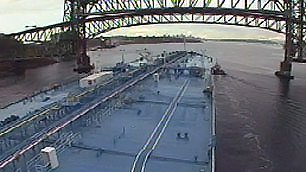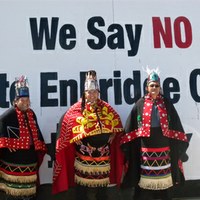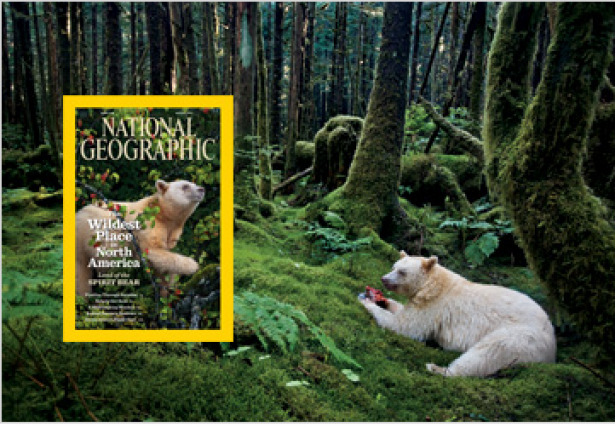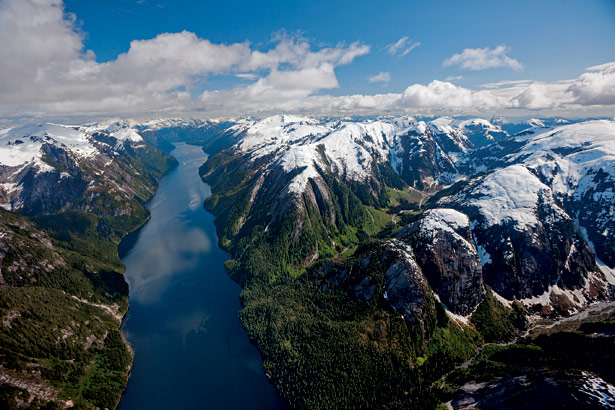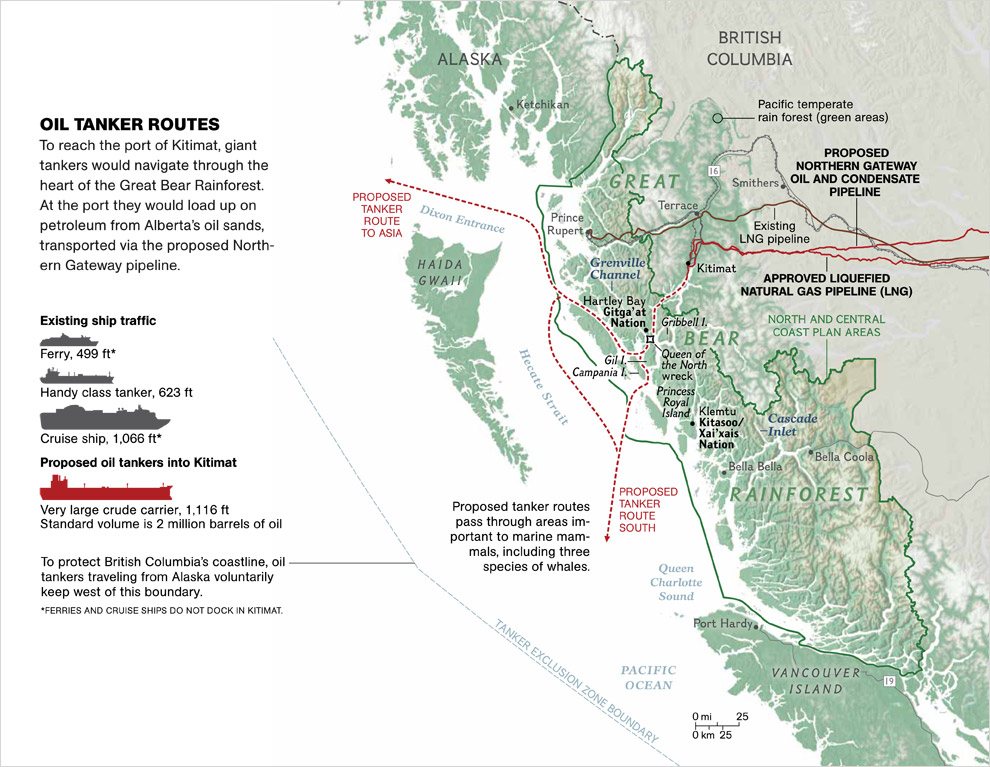
Click on image for full view of map
Why oil sands, a sunken ferry, and the price of oil in China have the Great Bear Rainforest in an uproar.
By Bruce Barcott
Photograph by Paul Nicklen
The Queen of the North was the pride of the BC Ferries fleet—right up until the night she sank. On March 22, 2006, during a routine run from Prince Rupert to Port Hardy, the ferry exited the narrow 45-mile Grenville Channel just past midnight. Then something went wrong. The officer at the helm, distracted by a conversation with another crew member, neglected to turn after leaving the channel, which points like a rifle barrel at the tip of Gil Island. At 12:20 a.m. the ferry's bow met the island's rock at a speed of 17.5 knots, ripping a hole in the hull. One hour and 20 minutes later, the Queen came to rest under 1,400 feet of water.
Of the 101 people aboard, 99 survived, thanks largely to the citizens of nearby Hartley Bay, who put to sea in fishing boats in the middle of the rainy, windy night to rescue them. Two passengers were never found. Today the Queen of the North remains where she sank. Every day, a little more fuel leaks out of her tanks, which still hold tens of thousands of gallons of diesel.
"We had to learn a new language," recalled Helen Clifton, a matriarch of the Gitga'at, one of the First Nations bands living along the coast. " 'Sheen,' 'shine,' 'burbling,' 'boom.' It opened our eyes to what happens in a disaster."
Now, when the Gitga'at people of Hartley Bay discuss the proposed Northern Gateway project, an oil pipeline that would turn these same waters into a supertanker expressway, they always mention the Queen. The accident taught them two lessons, they say. No matter how safe the ship, the most mundane human error can sink it. And when disaster strikes, they alone will be left to clean up the mess.
That leaves them skeptical about the pipeline and the tankers it would attract—about 220 a year. The government has already approved a fleet of liquefied natural gas tankers to call at nearby Kitimat in 2015. The oil tankers would be even bigger.
"I teach math at the school here," said Cameron Hill, a member of the Hartley Bay Band Council. "If I were to express the Queen of the North as an exponent, I'd say it was an x-squared disaster. The potential damage from those oil tankers is x to the 100th power."
With the Northern Gateway proposal, the Gitga'at and the rain forest that surrounds them have been caught up in a great geopolitical oil game. The Northern Gateway isn't just a pipeline. It's Canada's bid to become a global player in the petroleum market.
The proven reserves in Alberta's oil sands are second only to Saudi Arabia's oil fields, yet the United States today is virtually the sole export market for oil sands crude. A Canadian company, Enbridge, wants to build a $5.8 billion ($5.5 billion Canadian) pipeline to transport oil 731 miles, from Alberta to Kitimat. The double-barreled pipeline would carry oil west and send condensate, a liquid used to dilute the thick crude and allow it to flow, east to Alberta. Giant tankers—some nearly as long as the Empire State Building is tall, loaded with condensate or up to 2.15 million barrels of crude—would thread between a jigsaw of islands to and from Kitimat.
A West Coast oil port would open the Alberta oil sands to Asian markets, including China. Sinopec, China's state-owned oil company, is among the Asian refiners and Canadian oil firms that have invested $105 million into moving the Northern Gateway pipeline through the planning and permitting stage.
"We think it is hugely in Canada's national best interest to have a second outlet for our crude oil," Enbridge CEO Patrick Daniel has said.
The issue is no less critical for the Great Bear Rainforest, a wild stretch of western red cedar, hemlock, and spruce forest that runs 250 miles down British Columbia's coast. Whales, wolves, bears, and humans thrive in the rich marine channels and forests of the Great Bear, whose boundaries have never been precisely defined. "We don't want another Exxon Valdez on our shores," said Doug Neasloss, a Kitasoo/Xai'xais wildlife guide and marine planner.
Neasloss has hardly known a time when the rain forest wasn't a battleground. "When I was growing up here in the 1990s, there were almost no jobs," he said. "The unemployment rate in my hometown of Klemtu was closing in on 90 percent." Timber companies offered jobs. But wages from those jobs bought clear-cuts that reduced forests to stumps, destroying bear habitat and salmon spawning grounds.
In 1995 environmentalists began chaining themselves to trees and logging equipment to halt the cut. "Our community didn't welcome them at first," Neasloss recalled. "But then they all sat down and talked. Out of those discussions came the idea for the Great Bear Rainforest."
The battle continued for 15 years. By 2009 the province had put a third of the Great Bear off-limits to logging and the rest under ecosystem-based management. Areas are protected not only as parks but also as conservancies, where traditional activities can continue but industrial logging and development can't. A $126 million fund was set up to provide seed money for both conservation and economic development projects.
Just as the timber war wound down, the tanker war began.
Many of the same environmental groups involved in the timber fight are now opposing the oil pipeline, as are many of Canada's First Nations. "This is one of the biggest environmental threats we've ever seen," said Ian McAllister, co-founder of Pacific Wild, a wilderness protection organization that focuses on Canada's Pacific coast. "And it will become one of the biggest environmental battles Canada has ever witnessed. It's going to be a bare-knuckle fight."
The project is so big that the federal government has set up a joint review panel to oversee a two-year environmental assessment and permitting process, expected to conclude in late 2012.
The fight over the pipeline contains more than a few echoes of the battle over the trans-Alaska pipeline in the late 1960s and early 1970s. Back then, Alaska natives' land claims threatened to stop the project in its tracks. The issue was ultimately decided by the Alaska Native Claims Settlement Act, the largest land-claim settlement in U.S. history, which gave money and land to Alaska-native village and regional corporations and allowed the pipeline to be built.
So far no similar deal seems to be in the works. Last year 61 Canadian First Nations announced they would not allow the proposed pipeline to cross their traditional territory. Whether they have the legal authority to stop the pipeline is hard to say; aboriginal rights remain largely unsettled in British Columbia.
But that hasn't stopped Enbridge from courting the bands. "We want aboriginal economic participation in this project," said John Carruthers, president of Northern Gateway Pipelines. "We'd like them to own a stake that will establish a long-term benefit to First Nations communities." The company even offered financing to bring the bands aboard. So far there have been few takers.
"Buy in?" said Gitga'at council member Cameron Hill. "Buy in to what—to selling our way of life? We live off food from the land and sea here. We've been taught to respect what we take. That's sustained us from time immemorial. No amount of money can make us change our position."
The Canadian government's joint review panel is expected to mull over the issue for the next 18 months. Meanwhile, not far from Hill's home, the Queen of the North sends up an occasional burp of diesel fuel. In Hartley Bay the Queen may be dead, but she is not forgotten.
SOURCE: NATIONAL GEOGRAPHIC:
http://ngm.nationalgeographic.com/2011/08/canada-rainforest/barcott-text
